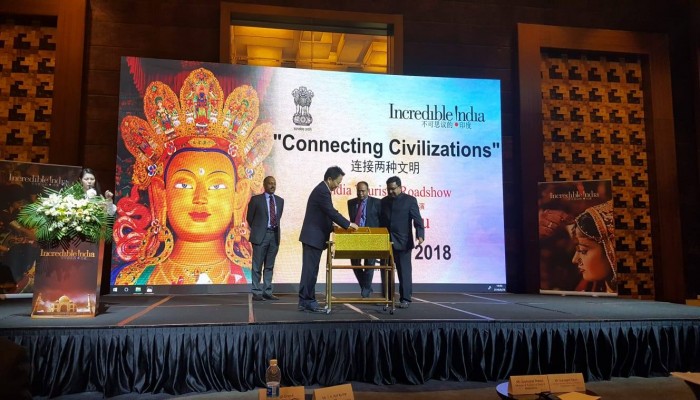Ample Scope for India to Better Leverage Travel and Tourism Sector
- In Economics
- 06:37 PM, Sep 28, 2018
- Mukul Asher
There is a strong case as well as ample scope for India to better leverage the travel and tourism sector (TTS).
According to the March 2018 Report on economic impact of travel and tourism in India by the WTTC (World Travel and Tourism Council), in 2017, total contribution of TTS was equivalent to 10.4 percent of global GDP, and over 300 million persons, 9.9 percent of global employment, were engaged in this sector.
Total contribution comprises direct contribution (accommodations, transport, entertainment, attractions); indirect contributions (mainly public and private investments in in the sector); and induced contribution (spending of direct and indirect employees).
In terms of total contribution to GDP, the Report estimates India’s global ranking in 2017 (out of 185 countries) as follows: absolute size: 7th; relative size: 99th; growth forecast (for 2018): 6th; and long -term growth (projection for 2018-2028): 4th.
India’s ranking of 99th in the relative size of the total contribution to GDP provides a strong rationale for better leveraging the TTS sector.
India’s large external trade deficit, which in 2017 was nearly USD 150 billion for merchandize trade, with surplus of only USD 30 billion in services trade, resulting in overall deficit of nearly USD 120 Billion. In 2017, India exhibited a surplus of only USD 9 billion.
The indications are that the overall trade deficit is expected to rise further due to uncertain and fragile global macroeconomic environment, including U.S. –China trade tensions, rising oil prices and interest rates, resulting in depreciation of the INR against the US Dollar, modest prospects for growth in net inward remittances (India receives between USD 65 to 70 billion in inward remittances, and provides between USD 8 to 10 Billion in outward remittances), and strong import demand.
India’s overall trade deficit at USD 27 Billion, and current Account Deficit at 2.4 percent of GDP were uncomfortably high in the second quarter of 2018.
India therefore needs to find more export avenues (such as defense and space exports); and to diversify its services basket to manage the external economy more sustainably. It is in this context that India needs to better leverage the TTS.
Size and Composition of India’s TTS
The actual figures and projections in the Report are based on constant 2017 prices and exchange rates.
Main features of the contribution of the TTS for India are as follows:
- Total Contribution of India’s TTS was INR 15240 Billion in 2017, equivalent to 9.4 percent of GDP. This is projected to rise to INR 32,050 billion in 2028, equivalent to 9.9 percent of GDP.
- The composition of total contribution in 2017 was 39 percent from direct, 50 percent for indirect, and 11 percent for induced contribution.
- The TTC sector accounted for 42 million livelihoods in 2017 (8 percent of the total); projected to rise to 52 million by 2028 (8.4 percent of the total).
This suggests generation of additional 10 million livelihoods in a decade.
- Direct contribution in 2017 was INR 5940 billion (3.7 percent of GDP); projected to rise to INR 12.680 billion (3.9 percent of GDP).
- India’s TTS sector is predominantly reliant on leisure spending (95 percent in 2017), with business spending accounting for only 5 percent. This lopsided shares need to be addressed.
- India’s TTS sector is also predominantly dependent on the domestic visitors, which accounting for 87 percent of total spending in 2017. The foreign visitors accounted for only 13 percent.
This lopsidedness also needs to be addressed.
- In 2017, foreign tourist arrivals in India were 10.2 million. India aims to increase its share to 2 percent of world tourist arrivals by 2025.
This Report, data of other international agencies, and the official tourism data of the Indian government do not provide data on the nights spent in India per international visitor, even on an aggregative basis. This is also the case with the domestic visitors.
An important avenue for increasing the contribution of the TTS sector is to explicitly strategize ways to increase the average stay per visitor. Anecdotal evidence suggests the average length of stay by international visitors is higher than the global average. Data analytics may be particularly useful in this area.
India’s earnings from international visitors were INR 1780 Billion (USD 27 Billion) in 2017. The target is to nearly double it to around USD 50 Billion by 2028.
These ambitious targets require requisite focus of investments in physical infrastructure, and in soft and hard skills.
In 2017, investments in India’s TTS sector were INR 2706 Billion (6.3 percent of the total). The projections are for it to increase to INR 5546 Billion (6.1 percent of the total). Public sector investments are expected to play a catalytic role.
India’s TTS Initiatives
India is taking several initiatives in the TTS sector. These encompass new investments in TTS infrastructure, more visitor friendly regulatory and visa (including e-visa), opening up new areas for tourism development with private participation, and skills development.
The Union government has designated five special tourism zones for development in partnership with the states.
India needs to speedily approve the National Tourism Policy draft, which incorporates the substance of the new TTS initiatives and goals.
It is also undertaking projects under the Blue Economy program, an important component of which is to use inland waterways and coastal shipping to ease movement of people and cargo. This will also make more accessible tourism areas, such as in the northeast, and provide additional options to travel to destinations, such as Goa, which are in high demand.
A reorganization of the tourism organizations of the Union and the state governments, with focus on governance, effectiveness, and monetizing large volume of assets, including valuable land, is also essential.
Reconfiguration of their physical and human resources would help improve asset utilization, inject needed skills-sets, and help generate fiscal space for greater investments, and operations and maintenance of tourist facilities.
The area, which still requires substantial focus, including behavioral change on the part of all stakeholders, is the creation of toilet, parking, and family and senior citizen friendly amenities, which are ample and consistently well maintained. This also applies to the trustees and management committees in charge of pilgrimage centers.
Using Swacch Bharat program to improve toilet facilities in frequently visited places merits consideration.
Another area where policy and effective implementation focus is needed, and whose importance also can not be over emphasized, concerns easing access to public amenities, and transport network around bus and railway stations, airports, and cruise, and ferry centers.
In particular, the Indian Railways, and concerned state and city government should consider addressing the above in a cooperative manner.
Specific recent initiatives of India in the TTS sector are briefly outlined below.
Blue Economy Related Initiatives
- India’s first luxury cruise line, with capacity of 400 passengers, is set to be operational from October 2018. It will initially operate from Mumbai –Goa-Mumbai sector. Both are important visiting destinations.
- A regular river cruise on the Pandu-Neamati River in the northeast region has been operating since 2016.
- A first phase of the Ro-Ro (roll-on Roll-Off) ferry service between Ghoga and Dahej in Gujarat, with capacity to ferry passengers and cars, became operational in October 2017. It has reduced the 310-kilometer of distance by road to just 30 kilometers. Further phases are planned, including to Mumbai.
- Gujarat State plans several more such Ro-RO services. The other states, such as Goa are also planning such services. Indeed there is large number of potential sites where Ro-Ro services could be economical, and provide efficiency gains, while enhancing the contribution of the TTS.
- India has plans to use the River Ganga as a major avenue to enhance access for visitors and transport goods.
UDAN
UDAN (Ude Desh Ka Aam Nagrik) Program seeks to connect under-served and non-operational existing airports, as well as to develop new airports in areas requiring greater connectivity.
This program is partly funded by the RCS (Regional Connectivity Scheme) levy from the airlines flying major routes. The levy is earmarked and is credited to the Regional air Connectivity Trust Fund (RACFT).
India now has about 100 functioning airports, and the number is expected to grow.
Its potential for enhancing the contribution to the TTS is illustrated by the inauguration of the Pakyong airport near Gangtok, the capital of the state of Sikkim on September 24, 2018. It is Sikkim’s first airport. It is built at the height of 4500 feet. Since land slides are not infrequent in the region, the airport will provide additional much valued option to domestic and overseas visitors to visit the eastern Himalayan region.
India’s aviation sector has been among the fastest growing globally. Such rapid growth has brought challenges that need addressing.
Thus, safety record of the airlines, and governance and regulatory structures relating to the sector need urgent attention.
Organizational restructuring of the Airports Authority of India, (AAI), and bringing it under the ambit of regulatory structure, merits serious consideration.
Human resources, including pilots, ground staff, cabin crew, air traffic controllers, and tour operators and guides also need to be augmented.
PRASAD and Swadesh Darshan
These are among the several initiatives for the TTS sector announced in India’s 2018-19 Union budget. PRASAD is an acronym for Pilgrimage Rejuvenation and Spiritual Augmentation Drive.
Under it, 13 cities would be the initial focus to develop infrastructure and amenities to facilitate visits to their pilgrimage sites.
Under Swadesh Darshan, integrated development of theme-based tourist sites is being developed.
Eco-Tourism Projects On India’s Islands
India set up Island Development Authority (IDA) in 2017.
NITI (National Institution for Transforming India) Aayog has prepared a draft concession agreement for developing eco-tourism projects in India’s around 100 islands. The projects will broadly use public-private partnership method.
Concluding Remarks
Leveraging the TTS sector in a more focused and professional manner to generate higher contribution to GDP, business activities, livelihoods, investments, and more sustainably manage the external sector is an urgent imperative for both the Union and the state governments in India. This requires cooperation of all stakeholders, including the travelling public.
India is taking several initiatives and setting ambitious targets to enhance the contribution of the TTS sector. There are realistic prospects of generating additional 10 million livelihoods from the TTS between 2018 and 2028.
As in many other areas, better data collection and policy-relevant use of data analysis is need for the TTS.
India’s transport infrastructure is improving rapidly both qualitatively and in terms of its length, and breadth. Creating such infrastructure is capital intensive and costly.
To generate economic returns, assets once created, must be maintained. In this task, India’s travelling public has an important role. To enjoy high quality transport services, including rail services, it must use it in a responsible manner. The tendencies to destroy public property during political protests also need to be curbed through appropriate disincentives.
In helping to realize the potential of the TTS, the importance of creating amenities and curbing rent seeking behavior among transport and other TTS operators cannot be overemphasized.
Disclaimer: The opinions expressed within this article are the personal opinions of the author. MyIndMakers is not responsible for the accuracy, completeness, suitability, or validity of any information on this article. All information is provided on an as-is basis. The information, facts or opinions appearing in the article do not reflect the views of MyindMakers and it does not assume any responsibility or liability for the same.







Comments